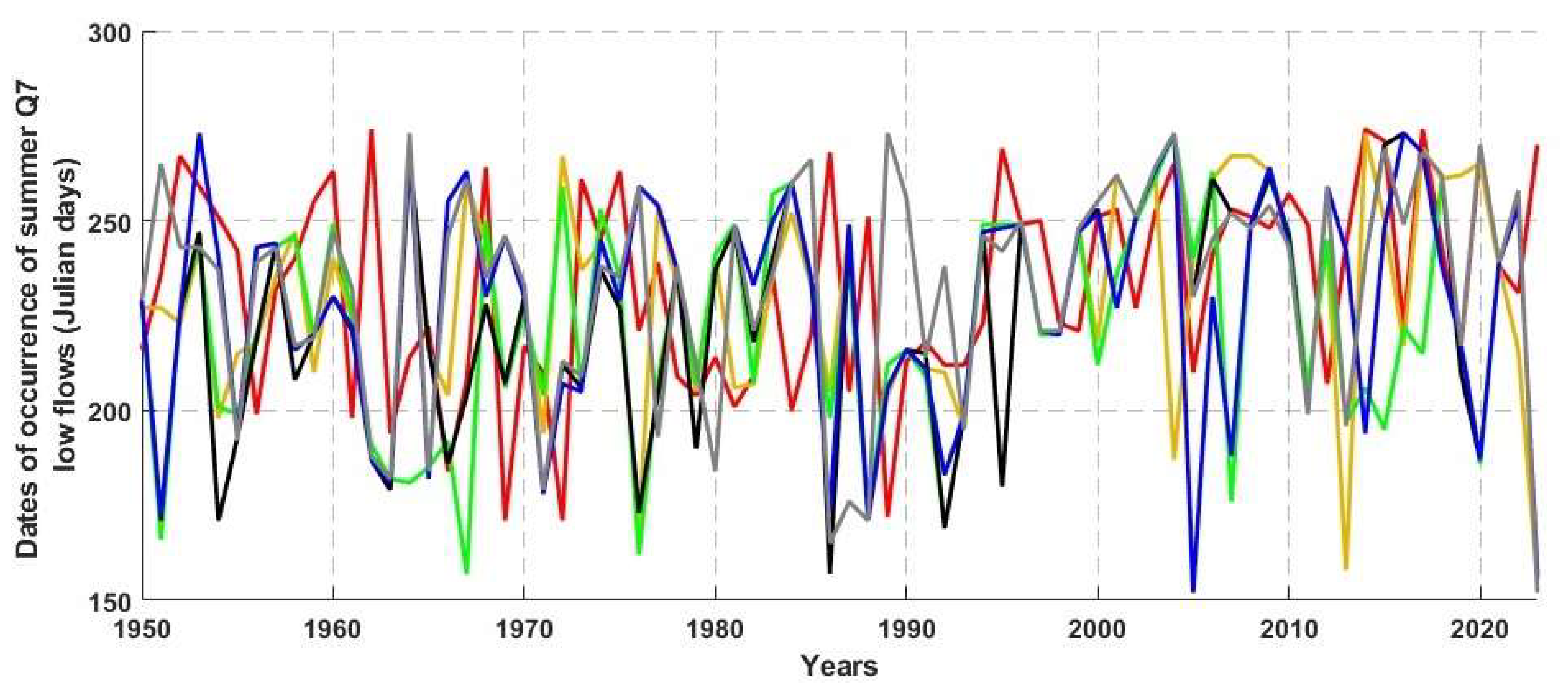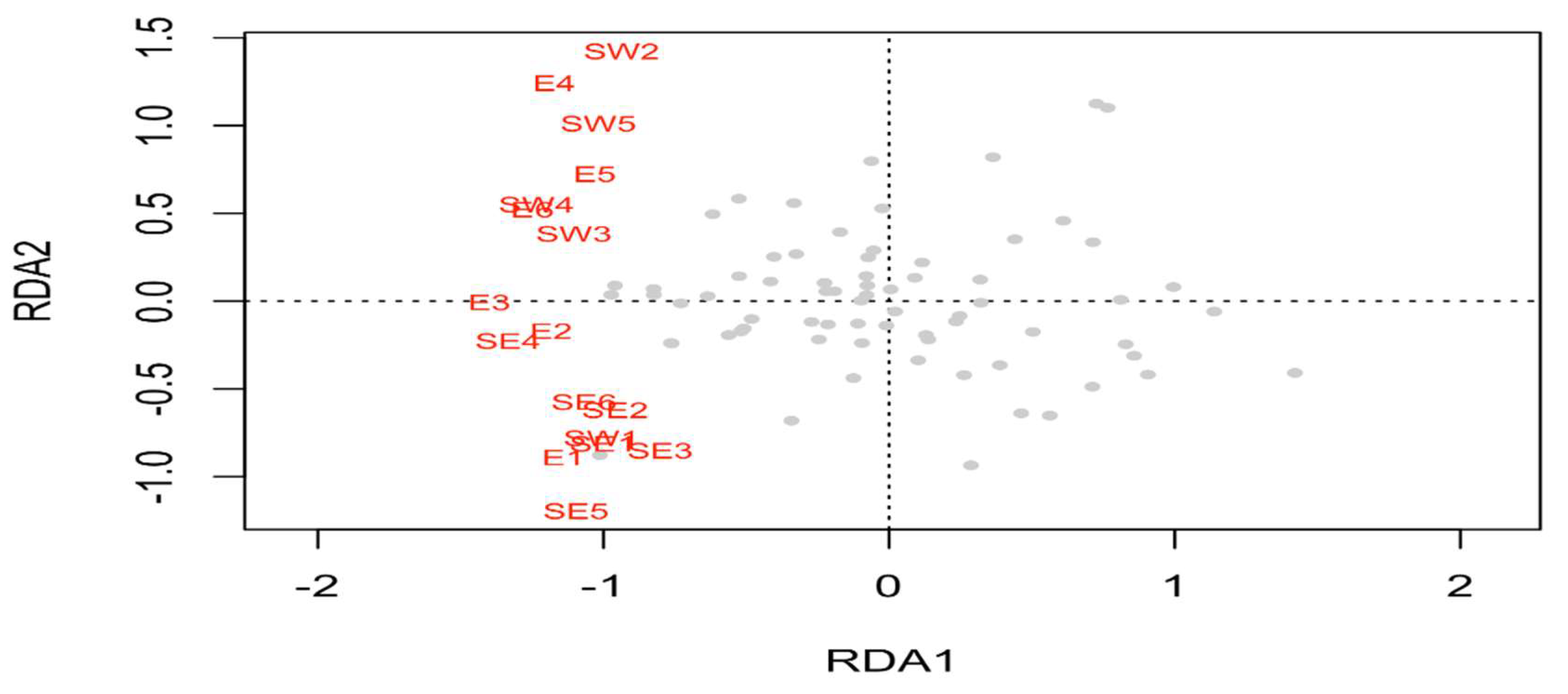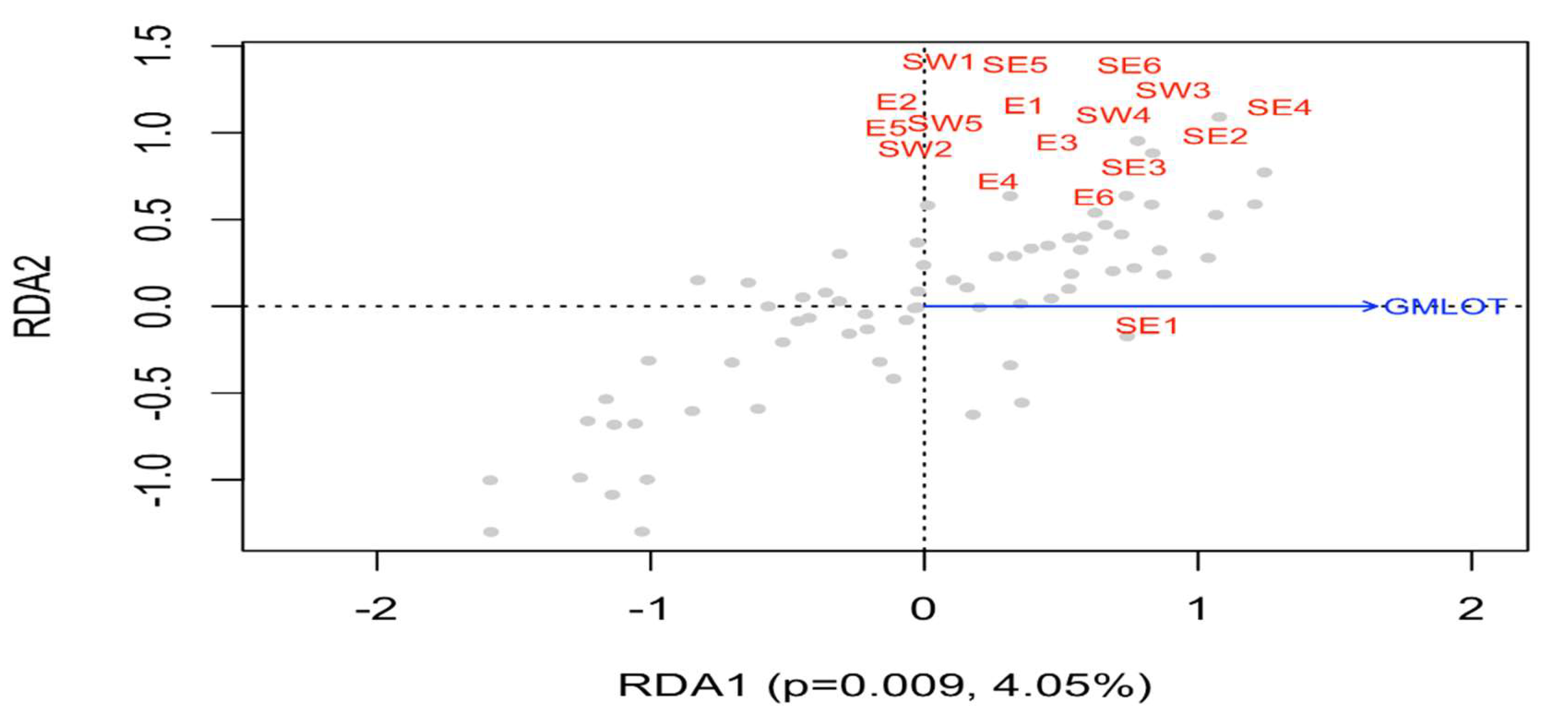Comparison of Factors of Spatiotemporal Variability of 7-Day Low-Flow Timing in Southern Quebec
Abstract
1. Introduction
- Determine the climatic, physiographic, and land cover/use factors that influence the spatial variability of 7-day low-flow timing.
- Analyze the long-term trend (stationarity) of the temporal variability of 7-day low-flow timing. The aim is to determine whether these 7-day low flows now tend to occur earlier or later in winter and summer.
- Determine the climate indices that influence the temporal variability of 7-day low-flow timing.
- Compare the climatic and physiographic factors of spatiotemporal variability that influence timing with those that influence the magnitudes of 7-day low flows.
2. Materials and Methods
2.1. Description of the Study Sites
2.2. Data Sources and Composition of Hydroclimatic Series
2.3. Statistical Analysis
3. Results
3.1. Comparison of Spatial Variability Factors of the Timing and Magnitude of 7-Day Minimum Flows in Winter and Summer
3.2. Comparison of the Temporal Variability of Timing and Magnitude of 7-Day Low Flows in Winter and Summer
3.2.1. Comparison of the Long-Term Trend
3.2.2. Relationship Between the Dates of Occurrence/Magnitude of 7-Day Flows and Climate Indices
4. Discussion
4.1. Spatial Variability of the 7-Day Low-Flow Timing
4.2. Temporal Variability of the 7-Day Low-Flow Timing
| Rivers | Winter | Summer | ||||||||||
|---|---|---|---|---|---|---|---|---|---|---|---|---|
| MK | STP | LTP | MK | STP | LTP | |||||||
| Z | p-Value | Z | p-Value | Z | p-Value | Z | p-Value | Z | p-Value | Z | p-Value | |
| Southeastern Hydroclimatologic Region | ||||||||||||
| Châteaugay | 2.469 ** | 0.014 | 2.243 ** | 0.025 | 2.359 ** | 0.0183 | 1.129 | 0.259 | 0.814 | 0.415 | 1.112 | 0.266 |
| Eaton | 1.773 * | 0.076 | 2.062 ** | 0.039 | 0.760 | 0.449 | −0.518 | 0.604 | −0.900 | 0.368 | −0.388 | 0.702 |
| Nicolet SW | 2.744 * | 0.006 | 2.500 ** | 0.012 | 3.135 ** | 0.002 | 2.623 ** | 0.009 | 2.624 ** | 0.009 | 2.173 ** | 0.029 |
| Etchemin | 2.585 ** | 0.010 | 2.938 ** | 0.003 | 1.796 * | 0.072 | 0.289 | 0.772 | −0.138 | 0.890 | 0.335 | 0.738 |
| Beaurivage | 4.505 ** | 0.000 | 4.545 ** | 0.000 | 3.236 ** | 0.001 | 3.157 ** | 0.002 | 2.990 ** | 0.003 | 2.727 ** | 0.006 |
| Du Sud | 1.078 | 0.281 | 1.205 | 0.228 | 1.133 | 0.257 | −1.363 | 0.173 | −1.386 | 0.166 | −1.617 | 0.109 |
| Eastern Hydrologic Region | ||||||||||||
| Ouelle | 0.519 | 0.604 | 0.501 | 0.617 | 0.305 | 0.761 | −1.745 * | 0.081 | −2.262 ** | 0.024 | −2.022 ** | 0.049 |
| Du Loup | 4.326 ** | 0.000 | 4.634 ** | 0.000 | 2.142 ** | 0.032 | 0.621 | 0.535 | 0.272 | 0.786 | 0.346 | 0.729 |
| Trois-Pistoles | 3.929 ** | 0.000 | 3.919 ** | 0.000 | 2.971 ** | 0.003 | −2.833 ** | 0.005 | −2.891 ** | 0.004 | −2.433 ** | 0.015 |
| Rimouski | 0.103 | 0.918 | 0.424 | 0.672 | 0.056 | 0.956 | −5.068 ** | 0.000 | −4.986 ** | 0.000 | −3.718 ** | 0.002 |
| Matane | 2.319 ** | 0.020 | 2.719 ** | 0.007 | 1.365 | 0.172 | −2.585 ** | 0.010 | −2.843 ** | 0.005 | −2.909 ** | 0.004 |
| Blanche | 4.616 ** | 0.000 | 4.624 ** | 0.000 | 2.850 ** | 0.004 | 0.910 | 0.363 | 0.767 | 0.443 | 1.032 | 0.302 |
| Southwestern Hydrologic Region | ||||||||||||
| Du Nord | 1.969 * | 0.049 | 2.053 ** | 0.040 | 2.150 ** | 0.032 | −3.248 ** | 0.001 | −3.329 ** | 0.001 | −1.926 * | 0.055 |
| Petite Nation | 3.705 ** | 0.000 | 3.681 ** | 0.000 | 3.770 ** | 0.001 | −0.243 | 0.809 | −0.291 | 0.771 | −0.244 | 0.814 |
| L’Assomption | 0.975 | 0.329 | 1.339 | 0.181 | 0.595 | 0.552 | −2.333 ** | 0.020 | −2.672 ** | 0.008 | −2.020 ** | 0.049 |
| Matawin | 1.022 | 0.307 | 0.729 | 0.466 | 0.441 | 0.659 | −0.028 | 0.978 | 0.948 | 0.343 | −0.020 | 0.988 |
| Vermillon | 2.462 ** | 0.014 | 2.115 ** | 0.035 | 2.013 ** | 0.044 | −3.281 ** | 0.001 | −3.415 ** | 0.001 | −3.434 ** | 0.001 |
5. Conclusions
Supplementary Materials
Funding
Data Availability Statement
Conflicts of Interest
References
- Poff, N.L.; Allan, J.D.; Bain, M.B.; Karr, J.R.; Prestegaard, K.L.; Richter, B.D.; Sparks, R.E.; Stromberg, J.C. The natural flow regime. A paradigm for river. Bioscience 1997, 47, 769–784. [Google Scholar] [CrossRef]
- Nilsson, C.; Svedmark, M. Basic principles and ecological consequences of changing water regimes: Riparian plant communities. Environ. Manag. 2002, 30, 468–480. [Google Scholar] [CrossRef]
- Beauchamp, M.; Assani, A.A.; Landry, R.; Massicotte, P. Temporal variability of the magnitude and timing of winter maximum daily flows in Southern Quebec (Canada). J. Hydrol. 2015, 529, 410–417. [Google Scholar] [CrossRef]
- Cunderlik, J.M.; Ouarda, T.B.M.J. Trend in the timing and magnitude of floods in Canada. J. Hydrol. 2009, 375, 471–480. [Google Scholar] [CrossRef]
- Déry, S.J.; Stahl, K.; Moore, R.D.; Whitfield, P.H.; Menounos, B. Detection of runoff timing changes in pluvial, nival, and glacial rivers of western Canada. Water Resour. Res. 2009, 45, W04426. [Google Scholar] [CrossRef]
- Hodgkins, G.A.; Dudley, R.W.; Huntington, T.G. Change in the timing of high river flows in New England over the 20th century. J. Hydrol. 2003, 278, 244–252. [Google Scholar] [CrossRef]
- Ehsanzadeh, E.; Adamowski, K. Trends in timing of low stream flows in Canada: Impact of autocorrelation and long-term persistence. Hydrol. Process. 2010, 24, 970–980. [Google Scholar] [CrossRef]
- Floriancic, M.G.; Berghuijs, W.R.; Molmar, P.; Kirchner, J.W. Seasonality and drivers of low flows across Europe and the United States. Water Resour. Res. 2021, 57, e2019WR026928. [Google Scholar] [CrossRef]
- Kormos, P.R.; Luce, C.H.; Wenger, S.J.; Berghuijs, W.R. Trends and sensitivities of low streamflow extremes to discharge timing and magnitude in Pacific Northwest mountain streams. Water Resour. Res. 2016, 52, 4990–5007. [Google Scholar] [CrossRef]
- Sadri, S.; Kam, J.; Sheffield, J. Nonstationarity of low flows and their timing in the eastern United States. Hydrol. Earth Syst. Sci. 2016, 20, 633–649. [Google Scholar] [CrossRef]
- Simeone, C.; McCabe, G.; Hecht, J.; Hammond, J.; Hodgkins, G.; Olson, C.; Wieczorek, M.; Woloch, D. Low-flow period seasonality, trends, and climate linkages across the United States. Hydrol. Sci. J. 2024, 69, 1387–1398. [Google Scholar] [CrossRef]
- Assani, A.A. Spatiotemporal variability of fall daily maximum flows in the southern Quebec (Canada) from 1930 to 2018. J. Flood Risk Manag. 2024, 17, e12971. [Google Scholar] [CrossRef]
- Brown, R.D. Analysis of snow cover variability and change in Québec, 1948–2005. Hydrol. Process. 2010, 24, 1929–1954. [Google Scholar] [CrossRef]
- Guerfi, N.; Assani, A.A.; Mesfioui, M.; Kinnard, C. Comparison of the temporal variability of winter daily extreme temperatures and precipitations in southern Quebec (Canada) using the Lombard and copula methods. Int. J. Climatol. 2015, 35, 4237–4246. [Google Scholar] [CrossRef]
- Yagouti, A.; Boulet, G.; Vincent, L.; Vescovi, L.; Mekis, E. Observed changes in daily temperature and precipitation indices for Southern Québec, 1960–2005. Atmos.-Ocean. 2008, 46, 243–256. [Google Scholar] [CrossRef]
- Assani, A.A. Comparison of Spatio-Temporal Variability of Daily Maximum Flows in Cold-Season (Winter and Spring) in Southern Quebec (Canada). Hydrology 2023, 10, 44. [Google Scholar] [CrossRef]
- Assani, A.A.; Zeroual, A.; Roy, A.; Kinnard, C. Spatio-temporal variability of seasonal daily minimum flows in the southern Quebec: Synthesis on the impacts of climate, agriculture and wetlands. Hydrol. Res. 2022, 53, 1494. [Google Scholar] [CrossRef]
- Ruiz, J. Modernization agriculture and agricultural land cover in Quebec (1951–2011). Cah. Géogr. Qué. 2019, 63, 213–230. (In French) [Google Scholar] [CrossRef]
- Kinnard, C.; Bzeouich, G.; Assani, A. Impacts of summer and winter conditions on summer river low flows in low elevation, snow-affected catchments. J. Hydrol. 2022, 605, 127393. [Google Scholar] [CrossRef]
- Berthot, L.; St-Hilaire, A.; Caissie, D.; El-Jabi, N.; Kirby, J.; Ouellet-Proulx, S. Environmental flow assessment in the context of climate change: A case study in Southern Quebec (Canada). J. Water Clim. Chang. 2021, 12, 3617. [Google Scholar] [CrossRef]
- Sneyers, R. On the Statistical Analysis of Series of Observations; Technical Notes, N°143; World Meteorological Organization: Geneva, Switzerland, 1990; 192p. [Google Scholar]
- Von Storch, H. Misuses of statistical analysis in climate research. In Analysis of Climate Variability; von Storch, H., Navarra, A., Eds.; Springer: Dordrecht, The Netherlands, 1995; pp. 11–26. [Google Scholar]
- Hamed, K.H.; Rao, A.R. A modified Mann-Kendall trend test for autococorrelated data. J. Hydrol. 1998, 204, 182–196. [Google Scholar] [CrossRef]
- Dinpashoh, Y.; Mirabbasi, R.; Jhajharia, D.; Abianeh, H.Z.; Mostafaeipour, A. Effect of short-term and long-term persistence on identification of temporal trends. J. Hydrol. Eng. ASCE 2014, 19, 617–625. [Google Scholar] [CrossRef]
- Fathian, F.; Dehghan, Z.; Bazrkar, M.H.; Eslamian, S. Trends in hydrological and climatic variables affected by four variations of the Mann-Kendall approach in Urmia Lake basin, Iran. Hydrol. Sci. J. 2016, 61, 892–904. [Google Scholar] [CrossRef]
- Kumar, S.; Duffy, C.J. Detecting hydroclimatic change spatio-temporal analysis of time series in Colorado River basin. J. Hydrol. 2009, 374, 1–15. [Google Scholar] [CrossRef]
- Yue, S.; Wang, C.Y. Regional streamflow trend detection with consideration of both temporal and spatial correlation. Int. J. Climatol. 2002, 22, 933–946. [Google Scholar] [CrossRef]
- Mazouz, R.; Assani, A.A.; Rodríguez, M.A. Application of redundancy analysis to hydroclimatology: A case study of spring heavy floods in southern Québec (Canada). J. Hydrol. 2023, 496, 187–194. [Google Scholar] [CrossRef]
- Lavigne, M.-P.; Rousseau, A.N.; Turcotte, R.; Laroche, A.-M.; Fortin, J.-P.; Villeneuve, J.-P. Validation and use of a semidistributed hydrological modeling system to predict short-term effects of clear-cutting on a watershed hydrological regime. Earth Interact. 2004, 8, 1–19. [Google Scholar] [CrossRef]








| Rivers | Code | ID | Drainage Area (km2) | Latitude (N) | Longitude (W) |
|---|---|---|---|---|---|
| Southwestern Hydroclimatic Region | |||||
| Petite Nation | SW1 | 40406 | 1331 | 45°47′ | 75°05′ |
| Du Nord | SW2 | 40110 | 1163 | 45°31′ | 74°20′ |
| L’Assomption | SW3 | 52219 | 1286 | 46°02′ | 73°26′ |
| Matawin | SW4 | 50119 | 1387 | 46°40′ | 73°55′ |
| Vermillon | SW5 | 50144 | 2662 | 47°39′ | 72°57′ |
| Southeastern Hydroclimatic Region | |||||
| Châteaugay | SE1 | 30905 | 2492 | 45°19′ | 73°45′ |
| Eaton | SE2 | 30234 | 646 | 45°28′ | 71°39′ |
| Nicolet | SE3 | 30101 | 562 | 45°47′ | 71°58′ |
| Etchemin | SE4 | 23303 | 1152 | 46°39′ | 71°39′ |
| Beaurivage | SE5 | 23401 | 708 | 46°39′ | 71°17′ |
| Du Sud | SE6 | 23106 | 821 | 46°49′ | 70°45′ |
| Eastern Hydroclimatic Region | |||||
| Ouelle | E1 | 22704 | 796 | 47°22′ | 67°57′ |
| Du Loup | E2 | 22513 | 1042 | 47°36′ | 69°38′ |
| Trois-Pistoles | E3 | 22301 | 930 | 48°05′ | 69°11′ |
| Rimouski | E4 | 22003 | 1615 | 48°24′ | 68°33′ |
| Matane | E5 | 21601 | 1655 | 48°46′ | 67°32′ |
| Blanche | E6 | 2170 | 223 | 48°47′ | 67°41′ |
| Winter | Summer | ||||
|---|---|---|---|---|---|
| Factors | Timing | Magnitude | Factors | Timing | Magnitude |
| Physiographic factors | |||||
| Drainage density (km/km2) | −0.0588 | −0.5629 ** | Drainage density (km/km2) | −0.2770 | −0.0057 |
| Mean Slope (°) | 0.5652 ** | 0.1471 | Mean Slope (°) | 0.3992 | 0.3092 |
| Forest surface area (%) | 0.5291 ** | −0.0882 | Forest surface area (%) | 0.3204 | 0.1508 |
| Agricultural surface area (%) | −0.5229 ** | −0.3329 | Agricultural surface area (%) | −0.5930 ** | −0.0211 |
| Wetlands surface area (%) | 0.2380 | 0.6653 ** | Wetlands surface area (%) | −0.1700 | −0.0243 |
| Climatic factors | |||||
| Winter total rainfall (mm) | −0.5595 ** | 0.3477 | Summer total rainfall (mm) | 0.3875 | 0.0429 |
| Winter total snowfall (cm) | 0.2889 | −0.3947 | Summer daily maximum temperature (°C) | −0.1700 | −0.0243 |
| Winter total precipitation (mm) | 0.0885 | −0.2406 | |||
| Winter daily maximum temperature (°C) | −0.4906 * | 0.4628 * | |||
| March daily maximum temperature (°C) | −0.2492 | 0.6579 ** | |||
| Rivers | Winter | Summer | ||||||||||
|---|---|---|---|---|---|---|---|---|---|---|---|---|
| MK | STP | LTP | MK | STP | LTP | |||||||
| Z | p-Value | Z | p-Value | Z | p-Value | Z | p-Value | Z | p-Value | Z | p-Value | |
| Southeastern Hydroclimatologic Region | ||||||||||||
| Châteaugay | −0.117 | 0.907 | 0.043 | 0.966 | −0.900 | 0.934 | 2.194 ** | 0.028 | 2.119 ** | 0.034 | 1.675 * | 0.094 |
| Eaton | 1.872 * | 0.061 | 2.523 ** | 0.024 | 3.028 ** | 0.003 | 2.316 ** | 0.021 | 2.329 ** | 0.020 | 2.053 ** | 0.040 |
| Nicolet SW | 2.101 ** | 0.036 | 2.329 ** | 0.020 | 2.580 ** | 0.010 | 1.527 | 0.127 | 1.624 | 0.104 | 0.980 | 0.327 |
| Etchemin | 0.948 | 0.343 | 1.119 | 0.263 | 0.645 | 0.519 | 3.188 ** | 0.001 | 3.291 ** | 0.001 | 2.533 ** | 0.011 |
| Beaurivage | 0.336 | 0.737 | 0.386 | 0.700 | 0.308 | 0.758 | 1.092 | 0.275 | 1.091 | 0.275 | 1.059 | 0.290 |
| Du Sud | 0.948 | 0.343 | 0.919 | 0.358 | 0.743 | 0.458 | 2.185 ** | 0.029 | 2.124 ** | 0.034 | 2.153 ** | 0.031 |
| Eastern Hydrologic Region | ||||||||||||
| Ouelle | 0.626 | 0.532 | 0.700 | 0.484 | 0.746 | 0.455 | 1.349 | 0.177 | 1.395 | 0.163 | 0.962 | 0.336 |
| Du Loup | −0.934 | 0.350 | −0.652 | 0.514 | −0.674 | 0.504 | −0.467 | 0.641 | −0.319 | 0.750 | −0.382 | 0.708 |
| Trois-Pistoles | 1.522 | 0.128 | 1.519 | 0.129 | 1.637 | 0.102 | 1.103 | 0.269 | 1.633 | 0.102 | 1.594 | 0.111 |
| Rimouski | 1.074 | 0.283 | 1.042 | 0.297 | 1.147 | 0.252 | 0.878 | 0.380 | 0.757 | 0.449 | 0.962 | 0.336 |
| Matane | 1.186 | 0.236 | 1.041 | 0.297 | 1.193 | 0.255 | −0.416 | 0.678 | −0.300 | 0.764 | −0.476 | 0.642 |
| Blanche | 1.970 * | 0.049 | 1.816 * | 0.070 | 1.660 * | 0.097 | 2.082 ** | 0.037 | 2.272 ** | 0.023 | 2.461 ** | 0.038 |
| Southwestern Hydrologic Region | ||||||||||||
| Du Nord | −0.836 | 0.403 | −0.634 | 0.527 | −1.039 | 0.304 | 0.341 | 0.737 | 0.119 | 0.905 | 0.456 | 0.648 |
| Petite Nation | 0.290 | 0.772 | 0.529 | 0.597 | 0.303 | 0.762 | −0.809 | 0.418 | −0.524 | 0.600 | −0.554 | 0.584 |
| L’Assomption | 0.332 | 0.740 | 0.319 | 0.750 | 0.332 | 0.740 | 1.621 | 0.105 | 2.081 ** | 0.037 | 1.329 | 0.184 |
| Matawin | 0.149 | 0.881 | 0.248 | 0.804 | 0.062 | 0.951 | 1.816 * | 0.069 | 1.900 * | 0.057 | 2.856 ** | 0.004 |
| Vermillon | −1.334 | 0.182 | −1.454 | 0.146 | −1.256 | 0.212 | 1.275 | 0.202 | 1.805 * | 0.071 | 0.644 | 0.519 |
Disclaimer/Publisher’s Note: The statements, opinions and data contained in all publications are solely those of the individual author(s) and contributor(s) and not of MDPI and/or the editor(s). MDPI and/or the editor(s) disclaim responsibility for any injury to people or property resulting from any ideas, methods, instructions or products referred to in the content. |
© 2025 by the author. Licensee MDPI, Basel, Switzerland. This article is an open access article distributed under the terms and conditions of the Creative Commons Attribution (CC BY) license (https://creativecommons.org/licenses/by/4.0/).
Share and Cite
Assani, A.A. Comparison of Factors of Spatiotemporal Variability of 7-Day Low-Flow Timing in Southern Quebec. Atmosphere 2025, 16, 1024. https://doi.org/10.3390/atmos16091024
Assani AA. Comparison of Factors of Spatiotemporal Variability of 7-Day Low-Flow Timing in Southern Quebec. Atmosphere. 2025; 16(9):1024. https://doi.org/10.3390/atmos16091024
Chicago/Turabian StyleAssani, Ali Arkamose. 2025. "Comparison of Factors of Spatiotemporal Variability of 7-Day Low-Flow Timing in Southern Quebec" Atmosphere 16, no. 9: 1024. https://doi.org/10.3390/atmos16091024
APA StyleAssani, A. A. (2025). Comparison of Factors of Spatiotemporal Variability of 7-Day Low-Flow Timing in Southern Quebec. Atmosphere, 16(9), 1024. https://doi.org/10.3390/atmos16091024






